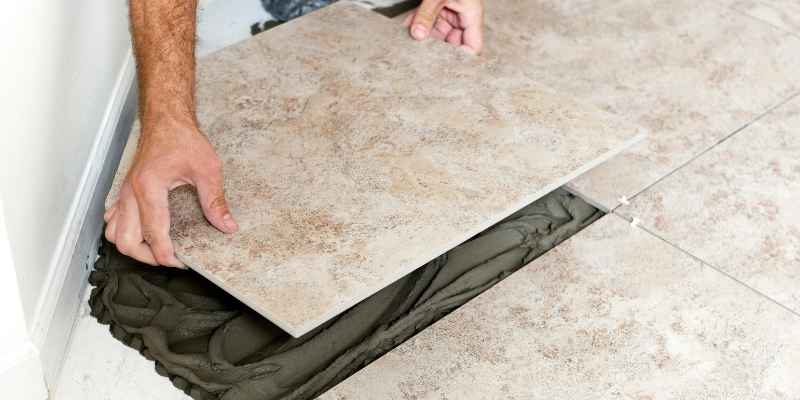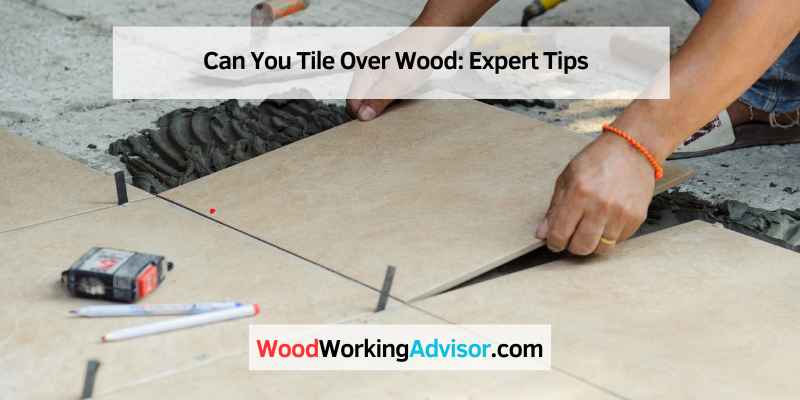Yes, you can tile over wood floors by using plywood or backer boards to ensure stability and prevent cracking. There is no need to concrete over the boards or remove them before tiling.
Tiling on top of wooden floors is a practical and cost-effective way to transform your space without major renovations. However, it is important to follow proper installation techniques to ensure long-lasting results. We will delve into the process of tiling over wood and provide you with helpful tips and guidance for a successful tiling project.
So, if you’re wondering whether you can tile on wood, the answer is yes, and we’ll show you how.
Preparing The Subfloor
Yes, you can tile over wood floors by first ensuring the subfloor is stable and level. Plywood or backer boards should be used for a sturdy foundation. Avoid direct tiling on floorboards to prevent tile and grout damage from potential movement.
Nailing Underlayment
If you’re considering tiling over wood, one crucial step in the preparation process is properly securing the underlayment. Nailing the underlayment ensures a stable and level surface for your tiles. This step helps prevent movement and flexing that could lead to cracked tiles or grout. It’s essential to use the right type and size of nails to ensure a secure bond.
Surface Preparation
Before laying your tiles, surface preparation is key to achieving a successful and long-lasting tile installation on wood. Here are some important steps to follow:
- Ensure the wood subfloor is dry and free from any moisture or water damage.
- Remove any existing flooring or carpeting and thoroughly clean the wood surface.
- Fill any cracks or gaps in the wood with a suitable wood filler.
- Sand down any uneven areas and ensure the surface is smooth and flat.
Note:
Proper surface preparation is vital to ensure the tiles adhere correctly and prevent future issues with cracking or loosening.
Once you’ve completed nailing the underlayment and prepared the surface, you’re ready to start tiling over wood. Remember to carefully follow the manufacturer’s instructions for tile adhesive and grouting to ensure a successful installation. With the right preparation and attention to detail, you can achieve a stunning tile floor, even when tiling over wood!
Methods For Tiling Over Wood
Tiling over wood can be a challenging task, but with the right methods, it is entirely possible to achieve a beautiful and durable tiled surface. When it comes to tiling over wood, there are several methods that are commonly used to ensure a stable and long-lasting tile installation. The most common methods for tiling over wood include using plywood or backer boards and utilizing self-leveling compound. Each method has its advantages and considerations, so let’s explore these approaches in more detail.
Using Plywood Or Backer Boards
One of the most popular methods for tiling over wood is to use plywood or backer boards as a stable and level substrate for the tile installation. This method involves installing a layer of plywood or backer boards over the existing wood surface to create a solid base for the tiles. By providing a flat and rigid foundation, plywood or backer boards help to minimize the risk of movement or flexing that could compromise the integrity of the tiled surface.
Self-leveling Compound
Another effective method for tiling over wood is to utilize self-leveling compound to create a smooth and even base for the tile installation. This approach involves applying a self-leveling compound over the wood surface to fill in any gaps or irregularities and ensure that the substrate is flat and uniform. Once the self-leveling compound has cured, the tiled surface can be laid on top, providing a stable and level foundation for the tiles.
Guidelines And Precautions

Before tiling over wood, make sure the surface is level and in good condition.
Inspect the wood for any damage or moisture issues that could affect tile adhesion.
When tiling over wood, it’s crucial to anchor the tiles securely to the substrate.
Use screws and washers to ensure the tiles are firmly in place.
- Ensure the wood is clean and dry before tiling.
- Use a suitable adhesive that is compatible with wood substrates.
- Allow for expansion joints to prevent tile cracking.
- Consider using a membrane to protect against moisture.
Summary
By following these guidelines and precautions, you can successfully tile over wood surfaces while ensuring durability and longevity.
Step-by-step Process
When it comes to tiling over wood, the step-by-step process is crucial to ensure a successful and durable installation. With the right materials and techniques, it is possible to tile over wood surfaces, adding a touch of modernity and elegance to any space. Here’s a detailed guide on the step-by-step process of tiling over wood.
Applying Thin-set Mortar
Before starting the tile installation, it’s crucial to apply a layer of thin-set mortar over the wooden surface. This will create a strong bonding layer for the tiles and provide stability. Using a notched trowel, spread the thin-set mortar evenly, ensuring complete coverage.
Setting And Grouting The Tiles
Once the thin-set mortar is applied, it’s time to set the tiles onto the wooden surface. Carefully lay the tiles in the desired pattern, using spacers to maintain consistent spacing. After the tiles are set, allow the mortar to dry completely before proceeding to the grouting stage.
- Make sure the grout lines are clean and free of any debris or excess mortar.
- Prepare the grout according to the manufacturer’s instructions and apply it using a grout float, ensuring the spaces between the tiles are completely filled.
- After applying the grout, use a damp sponge to clean off any excess grout from the tile surfaces.
Following these steps will result in a beautifully tiled wood surface that is both functional and aesthetically pleasing.
Expert Insights
Discover expert insights on how to effectively tile over wood floors without the need to remove or replace the existing surface. Learn the proper techniques to ensure a durable and visually appealing tile installation on wooden substrates.
When it comes to tiling and learning how to tile, there’s a lot of myths, questions, and uncertainty towards a particular question: Can you tile on wood? Simply, the answer is yes! Tiling over wooden floors is indeed possible, without the need to concrete over the boards or rip them up to start again.
Addressing Myths And Uncertainties
One common concern is the flexibility of floorboards, which makes them susceptible to movement. This movement could potentially cause tiles and grout to crack and break. However, there is a solution to overcome this issue. Instead of directly laying tiles on the wood, you can use plywood or backer boards as a stable and reliable base for tiling.
Professional Opinions
Experts in the tiling industry confirm that tiling over wood is a viable option. According to Fired Earth, a renowned tile supplier, there is no need to concrete over the boards or rip them up before tiling. Instead, they recommend using plywood or backer boards to ensure a durable and long-lasting tile installation.
Tile Giant, another reputable tile supplier, emphasizes the importance of preparing the wood surface properly. They advise against laying tiles directly over wooden floorboards due to their flexibility. By following their ultimate guide, which includes using plywood or backer boards and proper surface preparation, you can successfully tile on a wooden floor.
For those hesitant about removing their existing wood floor, the RUBI Tools Blog suggests an alternative approach. If the hardwood flooring consists of narrow boards with a smooth, flat surface, it is possible to leave the flooring in place. Simply screw cement backer board down on top of the wood before applying the tile.
Overall, professional opinions align on the feasibility of tiling over wood. By using appropriate materials and following proper preparation techniques, you can achieve beautiful and durable tile installations on wooden floors.
Additional Resources
Related Articles And Guides
Here are some related articles and guides to further your understanding of tiling over wood. Whether you’re a DIY enthusiast, a professional, or simply looking for more information, these resources can provide valuable insights.
Practical Tips From Tile Experts
In this section, you’ll find practical tips and advice from experienced tile experts to help you successfully tile over wood. These expert insights can offer valuable guidance and enhance your tiling project.

Frequently Asked Questions For Can You Tile Over Wood
Can You Put Tile Directly On Wood?
Yes, you can tile directly on wood floors without concrete or ripping them up. Use plywood or backer boards to ensure stability and prevent cracking or breaking of tiles and grout due to wood movement.
How Do You Lay Tile On A Wood Surface?
You can lay tile on a wood surface by preparing the subfloor, applying thin-set mortar, setting the tile, and grouting.
Should I Remove Wood Floor Before Tiling?
Yes, if the wood floor is level and in good condition, you can tile over it. Just make sure to follow the proper installation rules.
Can You Tile Over Wood 2×4?
Yes, you can tile over wood 2×4 by using plywood or backer boards for a stable surface.
Conclusion
Tiling over wood is indeed possible without the need to concrete over or rip up the boards. By using plywood or backer boards, you can lay tiles directly on top of wooden floors. It is important to follow the proper guidelines and ensure that the wood surface is level and in good condition.
With some careful preparation and attention to detail, you can achieve a beautiful tiled floor over wood. Say goodbye to myths and uncertainty, as the answer is a resounding yes, you can tile over wood!


